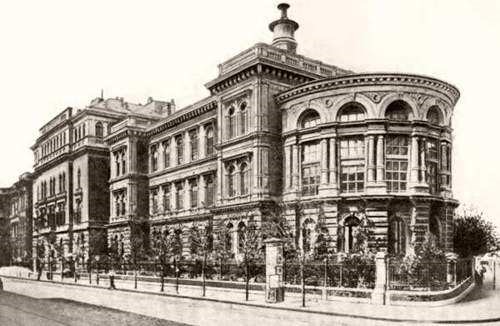Hungarian Royal University of Sciences, Faculty of Medicine Central Building
Budapest, 9th district, 26 Üllői Road.
The main building of the Faculty of Medicine of the Hungarian Royal University of Sciences is located on Üllői Road (number 26), between Mária Street and Szentkirályi Street.
Source:
The detailed history of Semmelweiss University https://semmelweis.hu/az-egyetemrol/az-egyetem-tortenete/a-semmelweis-egyetem-tortenete/
This is what it looks like today
Source:
The detailed history of Semmelweiss University https://semmelweis.hu/az-egyetemrol/az-egyetem-tortenete/a-semmelweis-egyetem-tortenete/

The main building of the Faculty of Medicine of the Hungarian Royal University of Sciences is located on Üllői Road (number 26), between Mária Street and Szentkirályi Street.
Source:
The detailed history of Semmelweiss University https://semmelweis.hu/az-egyetemrol/az-egyetem-tortenete/a-semmelweis-egyetem-tortenete/

This is what it looks like today
Source:
The detailed history of Semmelweiss University https://semmelweis.hu/az-egyetemrol/az-egyetem-tortenete/a-semmelweis-egyetem-tortenete/
THE IMPORTANCE OF THIS PLACE
Pál Ranschburg received his degree as a neurologist and psychiatrist at the Faculty of Medicine of the Hungarian Royal University of Sciences in 1895, and this is where he created his Psychophysiological Laboratory, which had a critical influence on the Hungarian history of psychology. After graduation, he received an unpaid internship at the Psychiatry Department led by Károly Laufenauer, and he joined the scientific research team there. In 1859, he took a study trip to Germany, France, and Switzerland. During this trip, he became familiar with the studies conducted in Wilhelm Wundt’s laboratory in Leipzig.
Inspired by this experience, in the academic year of 1898-1899, he created his laboratory commissioned by Laufenauer, which he equipped with instruments from the donation of a patient. This is where he conducted his pioneering studies on memory, which led to him establishing the principle of homogeneous inhibition (first published in 1902 in German). In spite of the successful work of the Psychophysiological Laboratory, in 1902, a decision by the Faculty Committee of the Medical University disputed the legal grounds of its operation. Pál Ranschburg’s assignment lasted until May 1st, 1902, and the new Head of Department appointed after Laufenauer’s early death, Ernő Moravcsik, did not wish to prolong it. After this, Ranschburg lost his position as a clinical intern and his laboratory was closed down.
THE HISTORY OF THE PLACE
In Budapest, the creation and fast development of a modern Faculty of Medicine took place between 1873 and 1911, at the time when Ranschburg started his career. The central block was a still-existing building between Üllői Road, Mária Street, Szentkirályi Street, and Baross Street (number 26 Üllői Street). After the constructions had started, the clinics, the botanical garden and the directorate were placed along the axis of Üllői Road, which, at the time, was on the edge of the city. Several well-equipped, up-to-date departments were founded in quick succession. The Psychiatry Department was founded in 1881 with the leadership of Károly Laufenauer, but its site was not on Üllői Road but in the Rókus Hospital until 1889, when part of the Department was moved into the central building of the Faculty of Medicine at 26 Üllői Road. The new Neurology and Psychiatry Clinic in Balassa Street was completed in 1908.
Sources
Hollán Henrik (1967). A Rókus Kórház története. Bp. Medicina